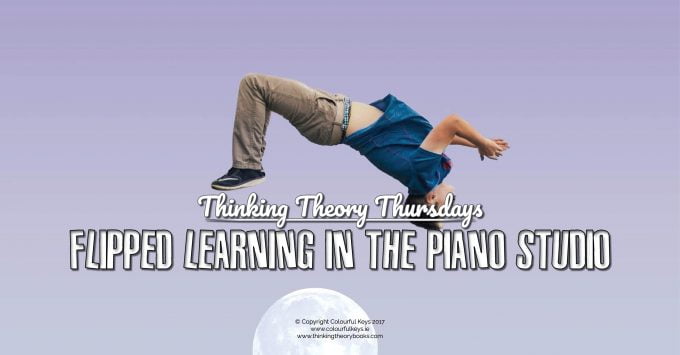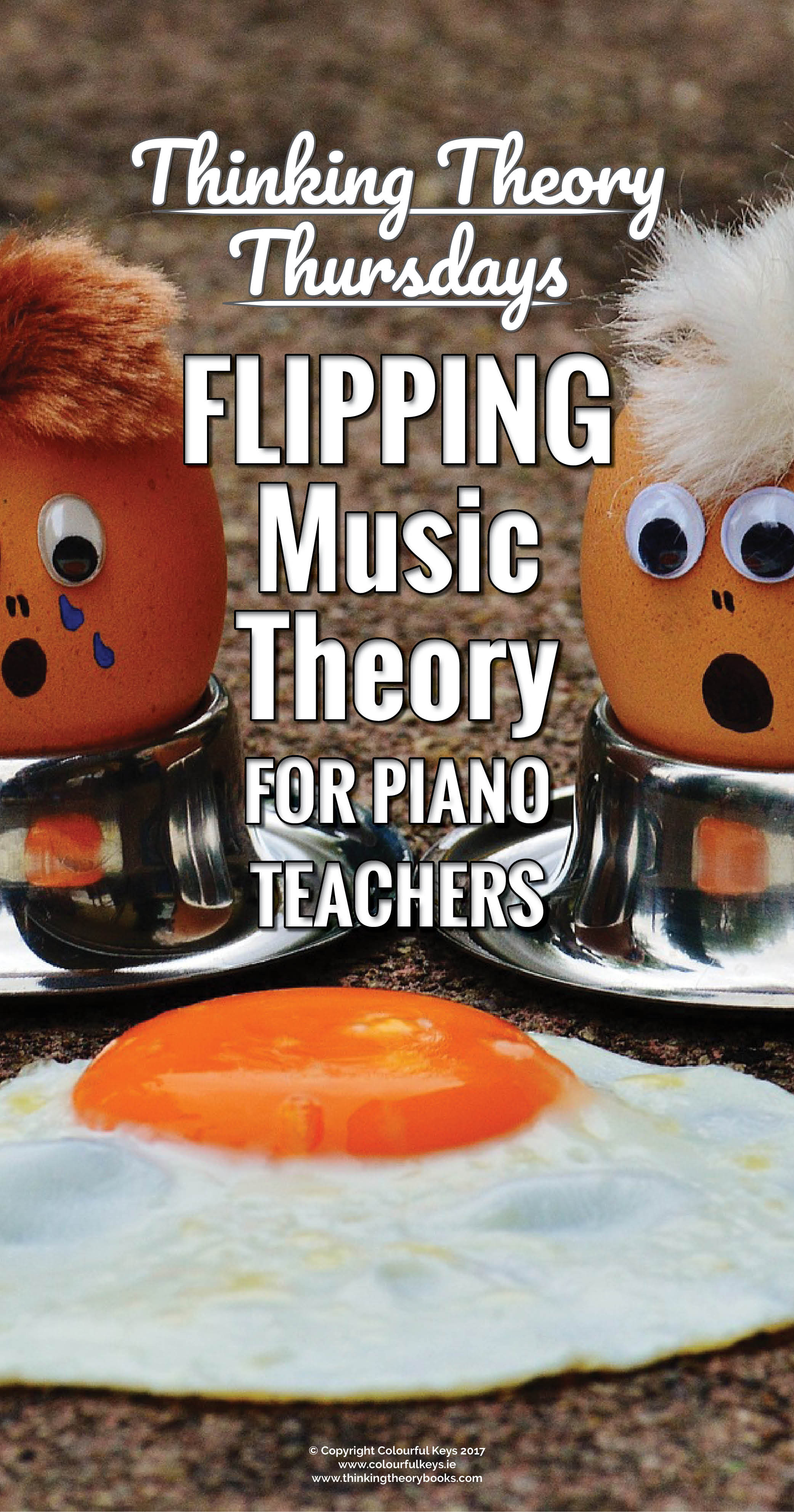Have you heard of the concept of “flipped learning”? If you have any connections to the world of classroom teaching, you probably have. In fact, it’s probably old hat to you by now. But what about flipped learning in the piano studio?
If you haven’t heard of flipped learning, the idea is basically to switch up homework and class time. So instead of sitting through a lecture or reading text in class, and reinforcing the concepts through worksheets at home, students do the opposite. They watch a video or have information introduced in some other way at home, and then they do the work in the classroom where the teacher can walk around and help individual students as needed.

So, how can we possibly apply flipped learning in the piano studio? What is there to flip about the way we teach piano? Many things possibly, but I’m going to be starting with music theory.
Why flip music theory?
Music theory can be hard. Enharmonics for example are confusing, and I find students are much more successful if I’m sitting beside them to ask prompting questions while they work on them. Questions like…
“Hmm, what note is that? And where is C flat on the piano?”
“Which clef is that though, should we rethink what note that is?”
All well and good, but then we run into that pesky 30 (or 45, or 60) minute time crunch again. How can we fit in time to explain a theory concept and walk through at least part of the workbook page together?
Enter flipped learning in the piano studio.
I’ve been working away recording simple and clear explanation videos for each of the concepts in my Thinking Theory Workbooks over the past few weeks. I’m just about ready to flip my students’ music theory homework.
Thinking Theory Videos
Each Thursday I’m going to be sharing a new Thinking Theory video here on the Colourful Keys blog. These videos will become part of my students weekly assignments going forward. Here’s how I envision the process working:
- I assign a video to the student and send the link to the piano parent.
- The student watches the music theory video a few times during the week and comes to the lesson with questions about it.
- We begin the pages that cover the concept in their Thinking Theory workbook during the lesson.
- The student completes the workbook pages at home, to further reinforce the music theory concept. If the concept is easy and the pages were completed during the lesson, I might go straight to assigning the next video instead.
- Rinse and repeat.
This will change, adapt and evolve with time (as everything does in teaching) but this is my starting framework. I’ll be sure to keep you updated as I modify, streamline and update my process. 🙂
Flip Your Piano Studio too!
The first video is up now and you’re welcome to use it with your students. This video correlates to page 1 & 2 of Thinking Theory Book One which covers crotchets, minims, dotted minims and semibreves.
Please note that for now, all the videos will use UK terms where applicable. If there is enough interest, I may consider making USA versions in the future. Let me know if that is something you’d like to see by leaving a comment below or emailing me.
The videos are now available in both international and USA versions.
UK/International Version
USA Version
You’re welcome to use this video in any way that’s helpful in your studio. Send the link to your piano parents, watch it in lessons together or use it in group classes.
If you’d like to follow along with the Thinking Theory Workbooks and try out flipped lessons in the piano studio too, you can purchase the workbooks here: www.thinkingtheorybooks.com.
More Flipped Thinking Theory
If you liked the approach of this video, you might also like these others:
- Flipped Basic Note Values
- Flipped Beginning Solfa
- Flip and Gameify Landmark Notes
- Flipped Time Signatures
- Flipped Note & Rest Values
- Flipped Dynamics
- Flipped Accidentals, Tones & Semitones
Have you integrated flipped learning in your piano studio?
What have you tried to make the best use of piano lesson time? What way do you teach music theory to your piano students?
Do you have any questions for me about this way of teaching?
Leave your thoughts, ideas and queries in the comments below.


Would love a version with US terms when you have time, I think this is something I would use, especially with older students as it is clear and concise.
Noted, thanks Stephanie!
I love flipping my piano lessons. I usually do it during their lab time but have sent videos home as well. I love that you are creating a series. Since you asked… I would love to see a US version. 😉
Great to hear you’re having flipping success in piano lessons already Jennifer. 🙂
I would be very interested in this for the US.
Cool, thanks Mysti!
I too would use a US version. I really lik that you kept the videos quickly paced.
Thanks Mary, I’m aiming for clear and concise. 🙂
I’d also love a US version. UK note names confuse me to no end! 🙂 Thank you for posting on flipped learning. This is a *great* idea!
Haha noted Nancy, they definitely are less straight forward than the US versions. Glad you like the flipped learning idea, hope you get a chance to try it out!
This sounds great! I love the idea of flipping things around. But I have many students who would not watch the videos at home. Do you have suggestions for that type of situation?
Hmm…well it’s about getting parents on board I think really Lisa. If you usually assign theory worksheets I think they would welcome switching to videos instead.
If they don’t do theory homework at all it might be harder sell. You could try having them watch the videos in the lesson while you correct their theory homework from the previous week perhaps?
Living in Australia I appreciate that your videos are not in US terms. Having introduced a Music Lab I think this would be something that would be great to use with students.
Oh great! Let me know how it goes Wendy!
Please…please….a U.S. version! 🙂
Haha, on the list Tracy! 😀
First of all! Your creative teaching approach is marvelous! I learn so much from you and your ideas and pass them on to my students- thank you , thank you! Yes, US versions please!
Hi Alisha, the US versions are done now, just adding them to the posts in the next few days. Stay tuned!